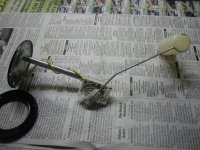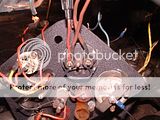Here are my latest findings on the Roadster Factory fuel tank sending unit I put in my TR3A.
I took the sending unit out of the tank and hooked the wires back up and held it near the gauge so I could see the Ohm meter as well as the gas gauge.
1) I noticed that the TRF sending unit float arm is 2 inches shorter than the original sending unit. When the TRF sender is full down, it is 10-1/2 inches from the bottom of the sender cap As a result, the TRF sender shows empty when I still have between 1/8 and ¼ tank of gas. I’m sure this also affects the gas gauge readings overall., except maybe when the tank is TOTALLY full.
2) The TRF sending unit has the name Frekans and the numbers 0 90. I assume the numbers are the ohm ratings for the sending unit. Note: I have attached a picture of the TRF sending unit. As part of the plastic base unit of the sender it has plastic stop at the top and a stop at the bottom.
3) While out of the gas tank with no wires attached., I measured the resistance of the TRF sending unit. At the bottom stop it measured 3.1 ohms. At the top stop it measured 100.1 ohms. So it is working. correctly.
4) With the sending unit out of the tank and with the wires hooked up and the sending unit float arm at the top stop, my gas gauge showed right at 7/8 full. I then put the float arm in the middle of the sending unit range and at 48/49 ohms expecting the fuel gauge to show ½ tank of gas, but the gauge only read ¼ full. Maybe the range is not linear.
Regards,
Bob


 Hey there Guest!
Hey there Guest!
 smilie in place of the real @
smilie in place of the real @
 Pretty Please - add it to our Events forum(s) and add to the calendar! >>
Pretty Please - add it to our Events forum(s) and add to the calendar! >> 


 A friendly reminder - be careful what links you click on here. If a link is posted by someone you don't know, or the URL looks fishy, DON'T CLICK. Spammers sometimes post links that lead to sites that can infect your computer, so be mindful what you click.
A friendly reminder - be careful what links you click on here. If a link is posted by someone you don't know, or the URL looks fishy, DON'T CLICK. Spammers sometimes post links that lead to sites that can infect your computer, so be mindful what you click.